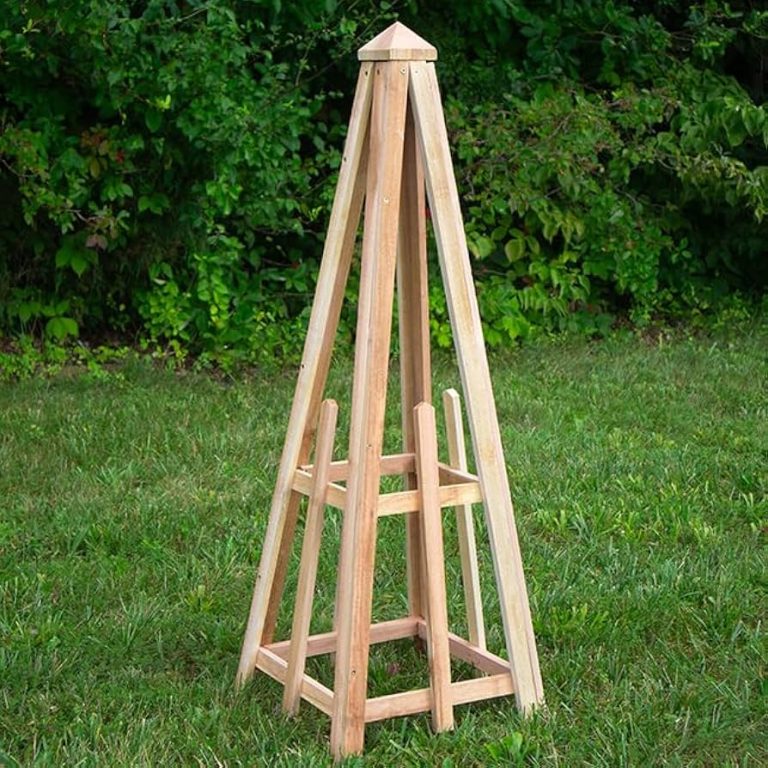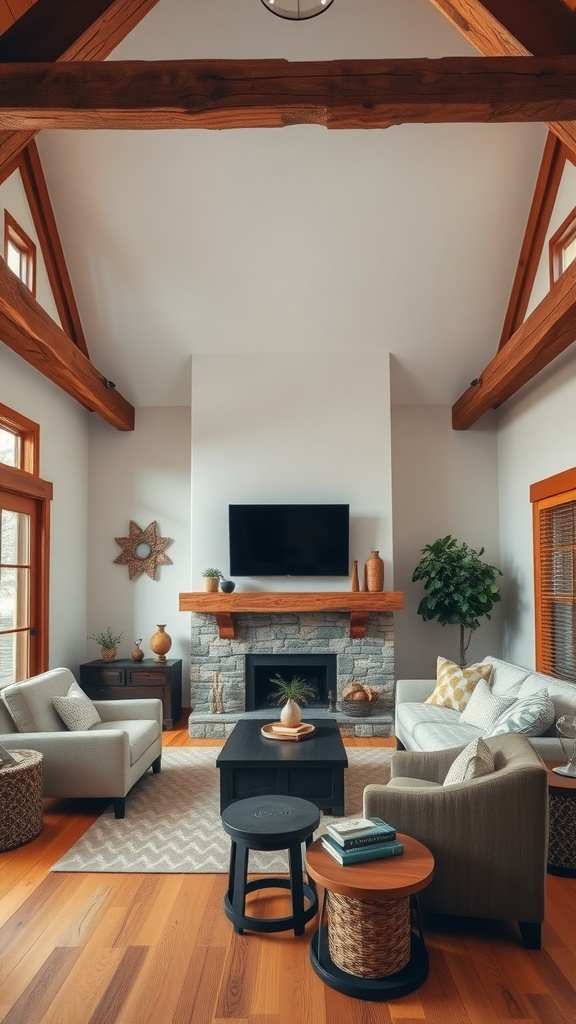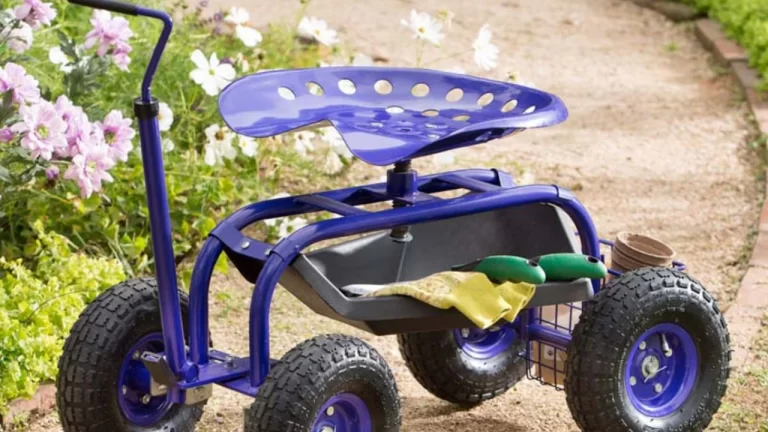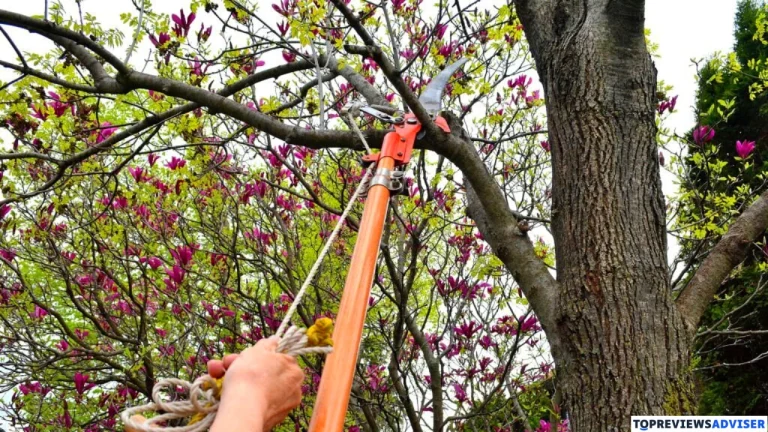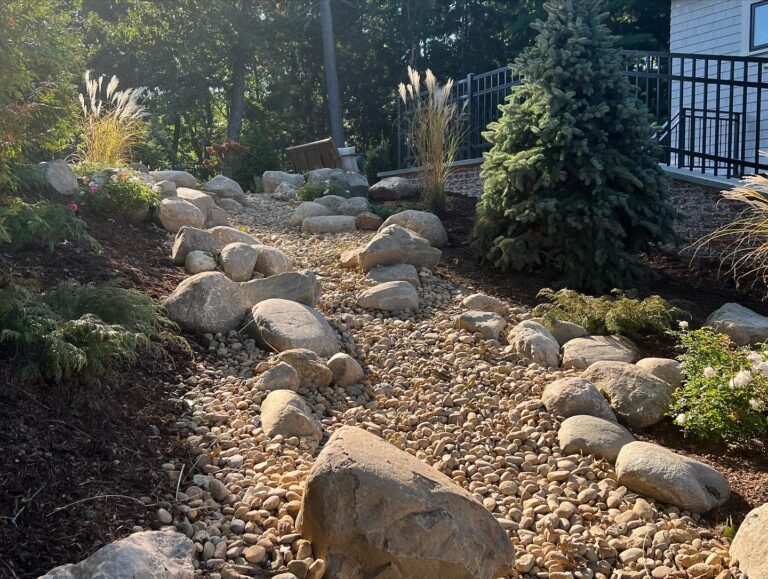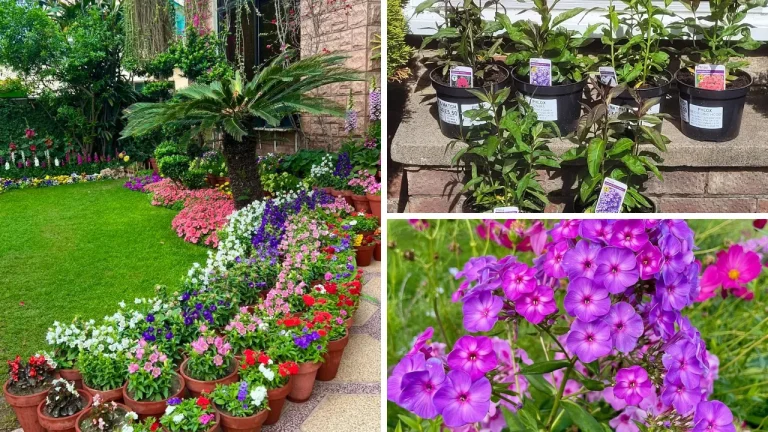How to Successfully Grow Potatoes in Pots and Bags
Gardening has always held a special place in my heart, offering a sanctuary of tranquility and a connection to the natural world. But as someone living in a small apartment with limited outdoor space, I often felt disheartened that I couldn’t indulge in this green thumb passion to the fullest. That was until I discovered the remarkable world of container gardening.
Container gardening opened up a whole new realm of possibilities, enabling me to unleash my gardening prowess even in the smallest of spaces. And when it comes to container gardening, few experiences are as gratifying as growing your own potatoes in pots. The sheer delight of planting a tiny potato seed and watching it transform into a thriving plant, brimming with delicious spuds, is unmatched.
If you, too, are longing to immerse yourself in the joys of growing potatoes, but don’t have access to a traditional garden, fret not. In this comprehensive guide, I will share with you my secrets for successfully growing potatoes in pots and bags, transforming your balcony, patio, or even windowsill into a fruitful potato garden. So grab your gardening gloves, and let’s embark on this exciting journey together!
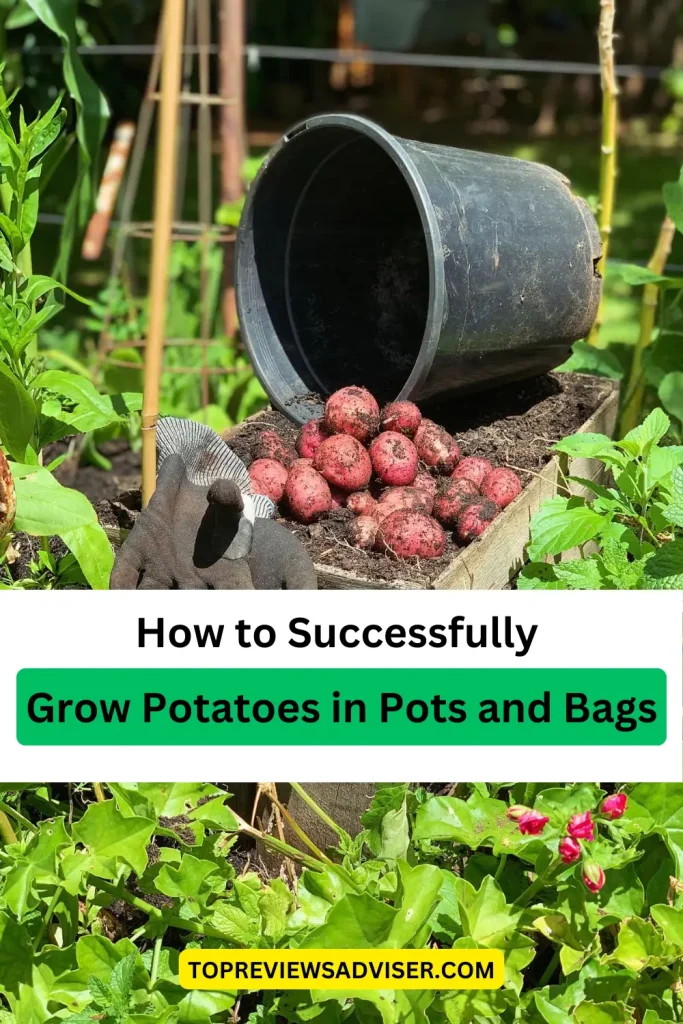
Key Takeaways:
- Discover the world of container gardening and its ability to unlock your green thumb passion.
- Learn the satisfaction of growing your own potatoes, even in small spaces.
- Unleash the potential of your balcony, patio, or windowsill by transforming it into a fruitful potato garden.
- Experience the gratification of planting a small potato seed and witnessing its transformation into delicious spuds.
Choosing the Right Potato Varieties for Containers

Not all potato varieties are suitable for growing in pots. When it comes to container gardening, selecting the right potato varieties is essential for a successful harvest. Whether you have limited space on your balcony or want to grow potatoes indoors, choosing the right varieties will ensure optimum growth and a satisfying yield.
Compact and Disease-Resistant Varieties: To maximize your potato container garden, look for compact varieties that don’t take up much space. These types of potatoes are perfect for small pots and bags. Additionally, opt for disease-resistant varieties to minimize the risk of common potato diseases that thrive in closed environments.
High-Yielding Varieties: When it comes to growing potatoes in containers, you want to get the most out of your harvest. Choose high-yielding varieties that have a reputation for producing abundant crops. These varieties will reward you with an ample supply of delicious spuds to enjoy.
A Variety for Every Preference: Potatoes come in different shapes, sizes, and flavors. Consider your culinary preferences when selecting potato varieties for containers. Do you prefer creamy and buttery potatoes for mashing or waxy potatoes for roasting? With a wide range of potato varieties available, you can find the perfect option to suit your taste buds.
“Choosing the right potato varieties for containers is crucial for a successful potato container garden. Whether you prioritize compactness, disease resistance, or high yields, there is a variety that will meet your needs and preferences.”
By carefully selecting potato varieties that are well-suited for container gardening, you’ll set yourself up for a fruitful and enjoyable growing experience. Now that you know how to choose the right potato varieties for containers, it’s time to move on to preparing the pots and soil.
Preparing the Pots and Soil
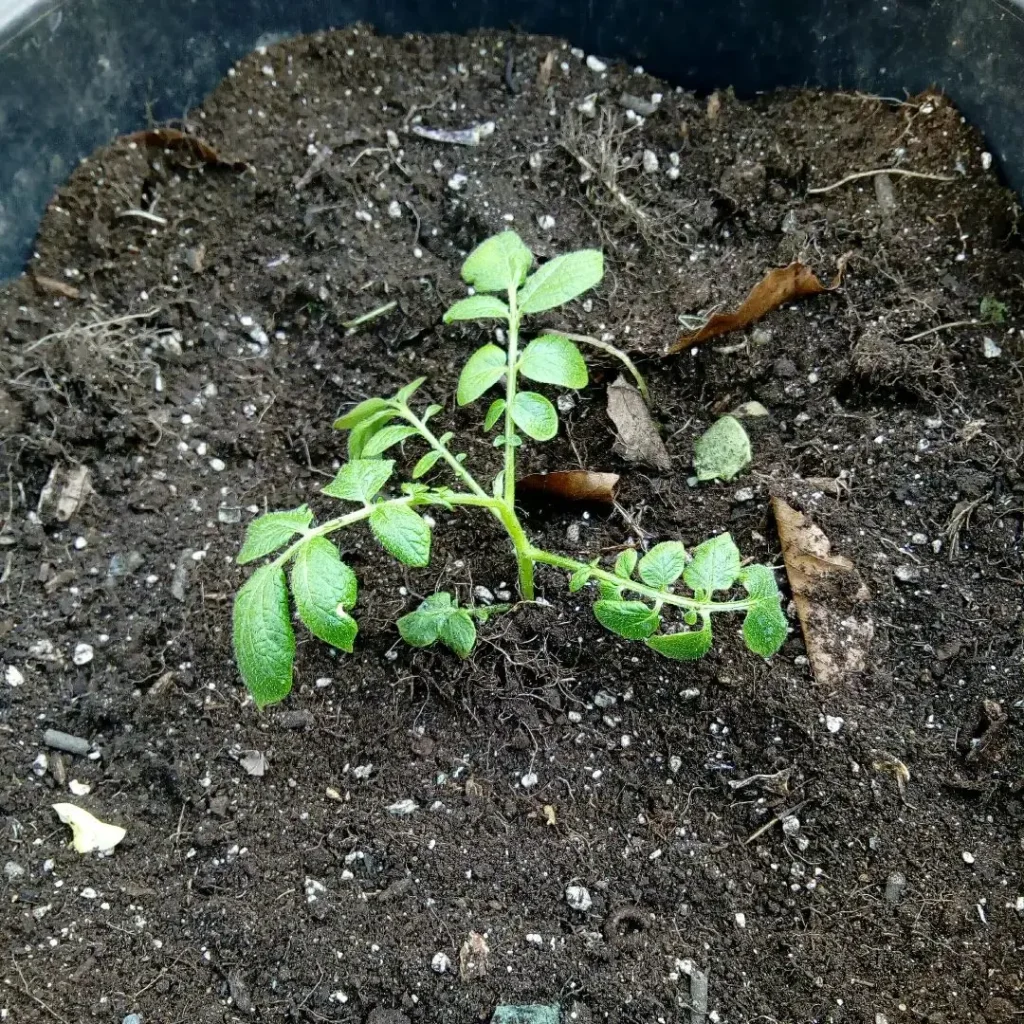
Properly preparing your pots and soil is essential for successful potato cultivation. By following these steps, you can create an optimal environment for your potato plants to thrive.
Choosing the Right Pots
When selecting pots for planting potatoes, opt for containers that are at least 12 inches deep. This depth allows ample room for potato tuber development. Look for pots with drainage holes to prevent waterlogging, ensuring proper drainage for healthy roots.
Preparing the Soil Mix
Creating the right soil mix is crucial for providing your potatoes with the necessary nutrients and drainage. You can prepare your soil mix by combining equal parts of garden soil, compost, and perlite or vermiculite. This mixture provides a good balance of nutrients, moisture retention, and drainage.
Ensuring Proper Drainage
To ensure proper drainage, place a layer of gravel or small stones at the bottom of your pots before adding the soil mix. This prevents water from collecting at the bottom and causing root rot. Additionally, consider using a pot with drainage holes and avoid overwatering your potato plants.
Tip: If you don’t have access to garden soil or compost, you can use a high-quality potting mix specifically formulated for vegetable gardening. These mixes often contain a blend of organic matter, peat moss, and perlite, providing the right texture and nutrients for potato growth.
By preparing your pots and soil properly, you are setting the stage for healthy potato growth. The next step is to plant your potatoes and watch them thrive!
Planting Potatoes in Pots
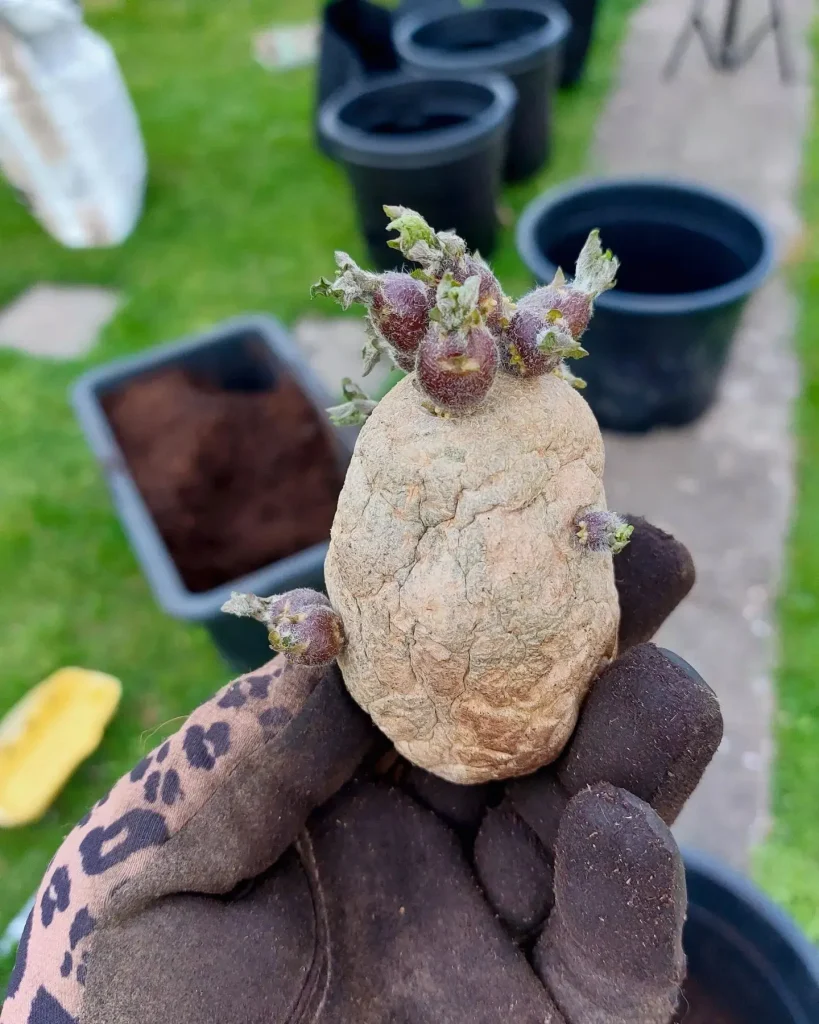
Now it’s time to plant your potatoes! Planting potatoes in pots is a straightforward process that can yield a bountiful harvest. Follow these simple steps to ensure successful growth and abundant potato production:
- Choose the right container: Select a pot or bag that is at least 16 inches deep to provide enough space for potato roots to grow. Ensure the container has drainage holes to prevent waterlogging.
- Prepare the soil: Use a well-draining potting mix with a good balance of nutrients. Avoid using regular garden soil, as it can be too compact for potted potatoes.
- Chit the potatoes: Chitting refers to the process of pre-sprouting potatoes before planting. Place the seed potatoes in a cool, well-lit area for a few weeks to encourage the growth of sturdy sprouts.
- Plant the potatoes: Fill the container with a few inches of soil, then place the chitted potatoes on top, ensuring the sprouts are facing upwards. Cover the potatoes with more soil, leaving about one inch of space below the rim of the pot.
- Space the potatoes: Depending on the size of your container, leave about 8-12 inches of space between each potato to allow for proper growth and encourage better airflow.
- Water and fertilize: After planting, water the potatoes thoroughly to settle the soil. As the plants grow, keep the soil consistently moist, but avoid overwatering. Begin fertilizing with a balanced organic fertilizer once the plants have established.
- Provide support: As the potato plants grow taller, they may need support to prevent them from toppling over. Consider using stakes or a trellis to provide support and keep the plants upright.
With the right containers, soil, and care, you’ll soon be on your way to enjoying a successful potato harvest from your own pots.
Caring for Your Potato Plants
To ensure vigorous growth and a bountiful harvest, your potato plants need proper care. In this section, I’ll provide you with valuable tips for maintaining healthy and thriving potato plants in containers. Whether you’re growing potatoes indoors or in traditional outdoor containers, these tips and potato container gardening hacks will help you maximize your crop’s potential.
Watering Techniques
Proper watering is crucial for the success of your potato plants. Overwatering can lead to rot and disease, while underwatering can result in stunted growth. Here are some watering tips for growing potatoes in containers:
- Water your potato plants regularly, keeping the soil consistently moist.
- Avoid waterlogged soil by ensuring proper drainage in your containers.
- Check the moisture level by sticking your finger about an inch into the soil. If it feels dry, it’s time to water.
- Consider using a drip irrigation system or a self-watering container to maintain optimal moisture levels.
Fertilizing Methods
Providing the right nutrients to your potato plants is essential for their growth and development. Here are some tips for fertilizing your potato containers:
- Choose a balanced fertilizer with equal proportions of nitrogen, phosphorus, and potassium.
- Apply a slow-release fertilizer at the time of planting to ensure a steady supply of nutrients throughout the growing season.
- Supplement with organic fertilizers, such as compost or aged manure, to enrich the soil and promote healthy root growth.
- Avoid overfertilizing, as it can result in excessive foliage growth at the expense of potato production.
Indoor Growing Hacks
For those growing potatoes indoors, here are some potato container gardening hacks to optimize your yield:
- Place your containers near a south-facing window or under grow lights to provide adequate sunlight for photosynthesis.
- Consider using reflective materials or mirrors to redirect sunlight onto your potato plants and enhance their growth.
- Create a DIY trellis or vertical planting system to maximize space and encourage upward growth.
- Monitor temperature and humidity levels to ensure optimal growing conditions for your indoor potato plants.
Tip: Don’t forget to rotate your potato containers every few days to ensure even exposure to light and prevent uneven growth.
By following these tips for growing potatoes in containers, you’ll be well on your way to cultivating healthy and productive potato plants. Remember, providing proper care, including regular watering, balanced fertilization, and implementing indoor growing hacks, will help you achieve a bountiful harvest of delicious homegrown potatoes!
Protecting Your Potato Plants
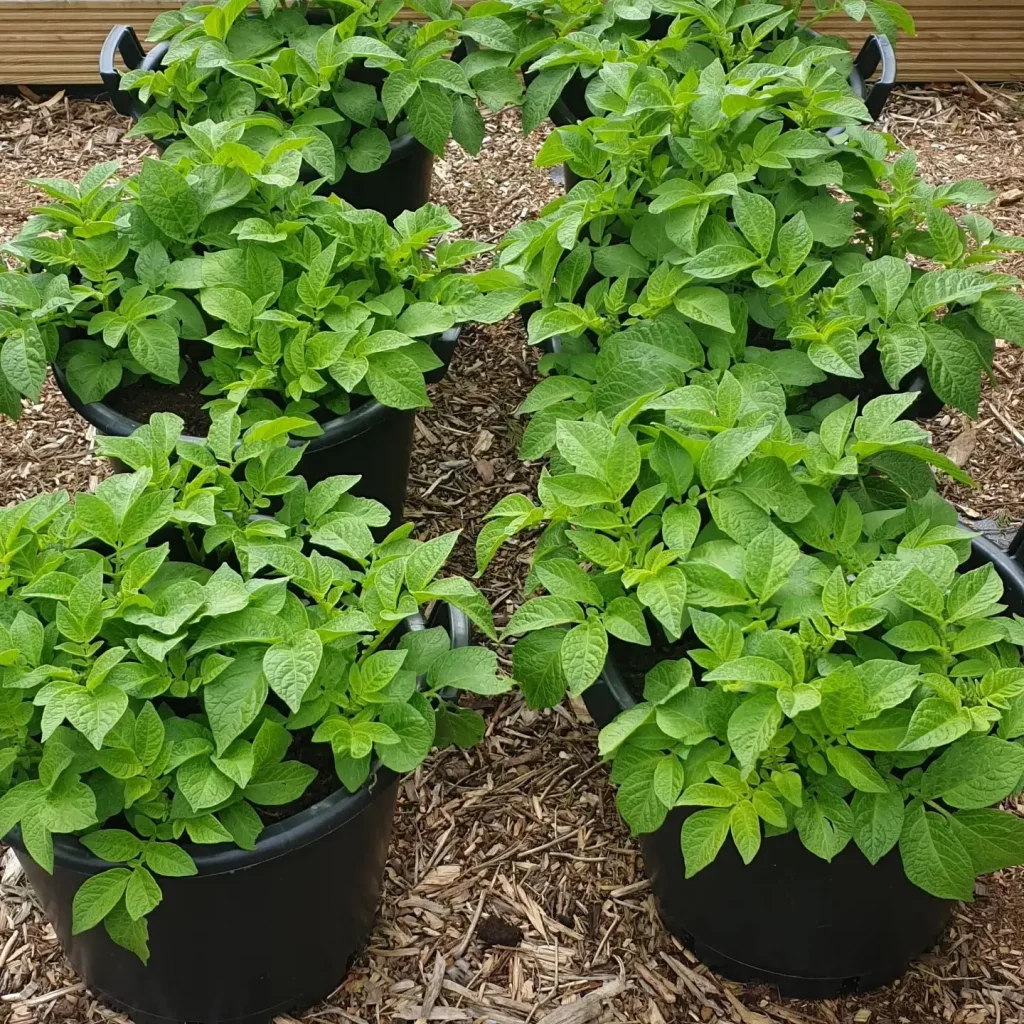
Potato plants are not immune to pests and diseases, but with the right strategies, you can keep them safe and thriving. In this section, I’ll share effective methods to protect your potato plants from common threats. By implementing these techniques, you can ensure a healthy and successful potato container garden.
1. Natural Pest Control Solutions
When dealing with pests, opting for natural solutions is a safe and eco-friendly approach. Some common pests that may attack your potato plants include aphids, Colorado potato beetles, and slugs. Here are a few effective ways to combat these pests:
- Introduce beneficial insects like ladybugs and lacewings, as they feed on aphids and other harmful pests.
- Handpick and remove Colorado potato beetles from your plants to prevent them from causing extensive damage.
- Create barriers around your pots or bags to deter slugs and snails, such as using copper tape or diatomaceous earth.
2. Preventive Measures
Prevention is key when it comes to protecting your potato plants. By taking proactive steps, you can minimize the risk of diseases and pest infestations. Here are some preventive measures to consider:
- Choose disease-resistant varieties when selecting your potato plants for container gardening.
- Rotate your crops by planting potatoes in different pots each year to prevent the buildup of pests and diseases in the soil.
- Avoid overwatering your potato plants, as excess moisture can lead to fungal diseases.
- Maintain good airflow around your plants by spacing them properly and pruning any overcrowded foliage.
Remember, prevention is always easier than dealing with a full-blown infestation or disease outbreak. By implementing these natural pest control solutions and preventive measures, you can protect your potato plants and ensure a successful harvest.
3. Organic Disease Control
In addition to preventing pests, it’s essential to be proactive in controlling and minimizing the spread of diseases. Here are a few organic disease control methods for your potato container garden:
- Practice good sanitation by removing and disposing of any infected plant material, reducing the risk of disease spread.
- Apply organic fungicides like copper-based sprays or neem oil to combat common fungal diseases such as early blight or late blight.
- Promote soil health by incorporating organic matter like compost or well-rotted manure, which improves the overall vigor and disease resistance of your plants.
By combining these organic disease control practices with natural pest control solutions and preventive measures, you can create a robust defense system for your potato plants.
4. Regular Monitoring
Regularly monitoring your potato plants is crucial for early detection of any pest or disease issues. Keep a close eye on your plants’ foliage, looking for signs of damage, wilting, or discoloration. By catching problems early on, you can take immediate action and prevent further damage.
| Pest/Disease | Signs and Symptoms | Control Measures |
|---|---|---|
| Aphids | Sticky residue, curled leaves | Introduce beneficial insects, use insecticidal soap |
| Colorado Potato Beetles | Defoliation, yellow eggs on leaves | Handpick and remove, use organic insecticides |
| Slugs | Irregular holes in leaves, silvery slime trails | Create barriers, use iron phosphate-based baits |
| Early Blight | Dark spots on foliage, target leaves | Remove affected foliage, apply copper-based fungicides |
| Late Blight | Dark lesions, white spores on leaves and stems | Remove affected foliage, apply copper-based fungicides |
By staying vigilant and promptly addressing any issues, you can protect your potato plants and ensure a thriving harvest.
Harvesting Potatoes from Containers
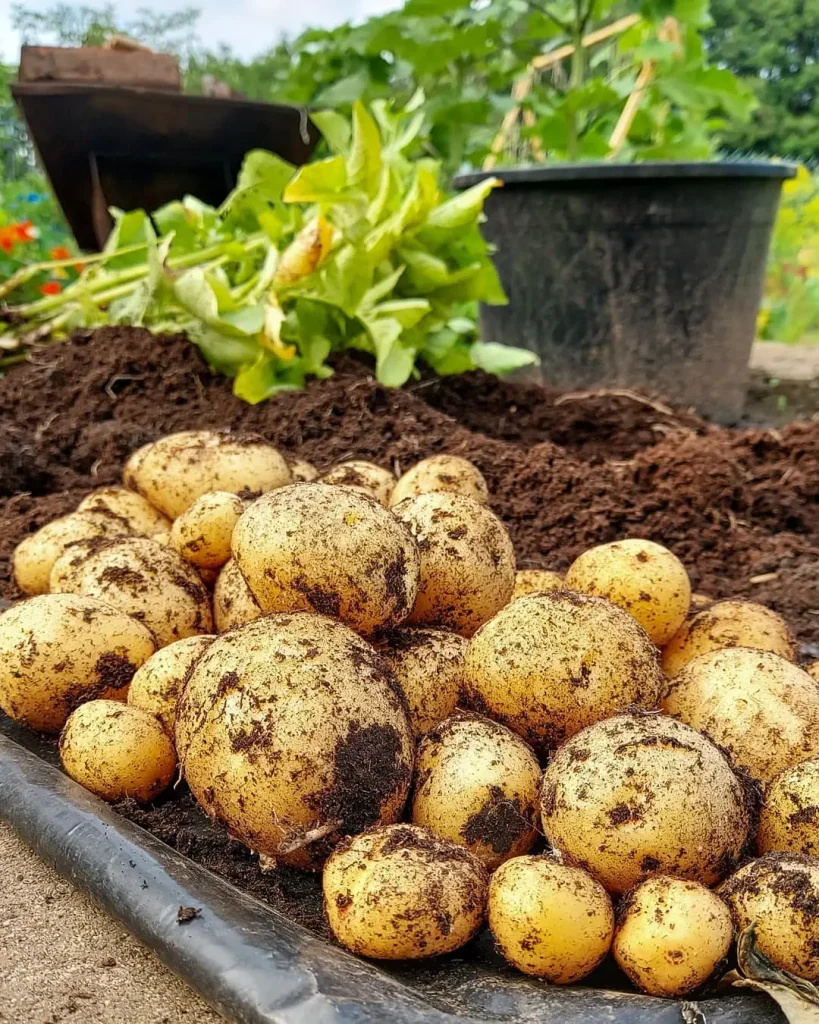
After weeks of patiently tending to your potato plants in containers, the day has finally come to reap the rewards of your hard work. In this section, I’ll walk you through the process of harvesting potatoes from containers, ensuring a successful and satisfying harvest.
Signs of Readiness
Before starting the harvesting process, it’s important to look out for signs that your potatoes are ready to be harvested. Mature potato plants will display yellowing and withering foliage, indicating that the plants have reached the end of their growth cycle. Additionally, gently brushing aside some soil near the base of the plant will give you a glimpse of the size and color of the potatoes beneath.
When harvesting new potatoes, you can start digging them up as soon as they reach the desired size, usually around 2-3 inches in diameter. These small, tender potatoes are a delicacy and are typically dug up before the plants have fully matured. For larger, mature potatoes, wait until the foliage has completely died back before proceeding with the harvest.
How to Harvest without Damaging the Potatoes
When it comes to harvesting potatoes from containers, it’s essential to handle them with care to avoid damage. Follow these steps to ensure a gentle and successful harvest:
- Loosen the soil around the base of the plant using a garden fork or hand trowel, being careful not to pierce or puncture the potatoes.
- Gently lift the entire plant from the container, cradling the foliage to prevent it from breaking off.
- Once the plant is out of the container, carefully brush off any excess soil to reveal the potatoes.
- Inspect the potatoes for any signs of damage or disease. Remove any damaged or diseased potatoes to prevent the spread of infection.
Proper Storage Techniques
Now that your potatoes are harvested, it’s important to store them properly to ensure their long-lasting freshness. Follow these storage techniques to keep your potatoes in optimal condition:
- Cure the freshly harvested potatoes by placing them in a cool, dark, and well-ventilated area for about two weeks. This allows the skin to toughen and minor cuts or bruises to heal, extending their storage life.
- After the curing period, choose a storage location that mimics the ideal conditions for potatoes. A cool, dry, and dark place with a temperature around 45-50°F (7-10°C) is ideal.
- Avoid storing potatoes near fruits, as fruits release ethylene gas, which can cause potatoes to sprout prematurely.
- Keep an eye on your stored potatoes and regularly inspect them for any signs of spoilage. Remove any sprouting or rotting potatoes promptly to prevent the spread of decay.
By following these harvesting and storage techniques, you can savor the delicious taste of homegrown potatoes long after the harvest season has ended. Now that you’ve successfully harvested your potatoes, it’s time to enjoy the fruits of your labor in a variety of delicious potato dishes!
Overcoming Common Challenges in Potatoes in Pots
While growing potatoes in containers offers numerous advantages, it’s not without its challenges. In this section, I’ll address common issues faced by potato growers and provide valuable tips and solutions for overcoming them. Whether you’re dealing with nutrient deficiencies, excessive heat, or limited space, I’ve got practical advice to help you successfully navigate these challenges.
1. Nutrient Deficiencies
One common challenge when growing potatoes in pots is nutrient deficiencies. Container-grown potatoes have limited access to nutrients compared to those grown in the ground. To ensure your plants receive adequate nutrition:
- Use a high-quality potting mix enriched with organic matter for better nutrient retention.
- Regularly fertilize your plants with a balanced organic fertilizer, following the package instructions for dosage and frequency.
- Consider adding compost or well-rotted manure to the soil mix to enhance its nutrient content.
2. Excessive Heat
Excessive heat can pose a challenge to potatoes grown in containers, as the limited soil volume can quickly heat up and damage the plants. Here are some tips for managing heat stress:
- Choose a suitable location for your containers, avoiding direct sunlight during the hottest part of the day.
- Provide shade by placing your containers near a wall, fence, or taller plants that can create some relief from the sun.
- Water your potatoes regularly, keeping the soil consistently moist but not waterlogged.
- Mulch the soil surface with straw or organic mulch to help maintain moisture and regulate soil temperature.
3. Limited Space
When growing potatoes in containers, space can be a limiting factor. However, with strategic planning and proper care, you can maximize your potato yield even in a confined area:
Consider using vertical gardening techniques such as stacking containers or utilizing hanging baskets to make the most of your available space.
Choose compact varieties that are better suited for container growing.
Practice regular pruning and deleafing to control the plant’s size and encourage airflow, reducing the risk of disease.
By implementing these tips, you’ll be well-equipped to overcome common challenges and enjoy a successful potato harvest from your containers. Don’t let these obstacles discourage you; instead, view them as opportunities for learning and growth. Happy potato gardening!
Extending Your Potato Container Harvest
Looking to make the most of your potato container gardening efforts? I’ve got you covered! In this section, I’ll share some expert tips and clever hacks that can help you extend your potato crop and enjoy a harvest that keeps on giving. Let’s dive in!
1. Succession Planting for Continual Harvest
If you want a continuous supply of fresh potatoes throughout the growing season, try succession planting. This technique involves planting new potatoes at regular intervals, ensuring a staggered harvest. Start by planting a batch of potatoes in your containers. Once those plants are well-established, plant a new batch in separate pots. By timing your plantings appropriately, you can enjoy a steady supply of potatoes from early summer all the way through fall.
2. Introduce Companion Plants to Maximize Yield
Companion planting is a smart strategy that can benefit your potato plants in multiple ways. Consider planting companion plants like marigolds, which not only add beauty to your container garden but also help repel pests that could harm your potatoes. Additionally, interplanting potatoes with herbs like basil or dill can improve soil health and deter certain pests, helping your potato plants thrive.
3. Optimize Soil Nutrition for Extended Growth
Keeping your potato plants well-nourished is key to maximizing their growth potential. As your plants continue to develop, regularly replenish the nutrients in the soil. You can achieve this by applying a slow-release organic fertilizer or incorporating compost into the container. This ensures that your plants have access to the essential nutrients they need for a prolonged growing season and a bumper potato harvest.
4. Try Vertical Growing Systems
If you’re short on space but still want to grow more potatoes, vertical gardening is your answer. Vertical growing systems, such as potato towers or bags, allow you to stack multiple layers of containers, creating a vertical garden. As the plants grow, gently add more soil and stack additional containers, giving your potato plants more room to produce more tubers. Not only does this method save space, but it also expands your harvest potential in limited areas.
| Pros | Cons |
|---|---|
| Maximizes space utilization | Requires additional containers |
| Increases potato yield with multiple layers | Requires careful watering and maintenance |
| Easy harvesting from the top layer | Can limit air circulation if not properly managed |
5. Monitor Soil Moisture and Temperature
Maintaining optimal soil moisture and temperature conditions is essential for an extended potato growing season. Regularly check the moisture levels in your containers and water as needed to prevent the soil from drying out. Additionally, monitor the soil temperature to ensure it remains within the ideal range for potato growth. By providing consistent moisture and a favorable temperature, you’ll encourage your potato plants to continue thriving and producing tubers.
Expert Tip: To protect your potato plants from excessively high soil temperatures, consider using reflective mulch or light-colored containers. These materials help reflect the sun’s rays, reducing heat buildup and keeping the soil cooler.
By implementing these tips and potato container gardening hacks, you’ll be well-equipped to extend your potato harvest and enjoy an abundance of homegrown spuds. Get creative, experiment with new techniques, and watch your container garden flourish with delicious potatoes!
Conclusion
In conclusion, growing potatoes in pots and bags is a rewarding and convenient way to enjoy homegrown spuds. By following the steps and tips outlined in this guide, you can successfully grow potatoes in pots and achieve a plentiful harvest, even in a small space. Whether you have a balcony or a patio, you can savor the incredible taste of freshly grown potatoes right at home.
Container gardening offers numerous advantages, such as flexibility, portability, and the ability to control soil conditions. It allows you to experiment with different potato varieties that thrive in containers, such as the Yukon Gold, Red Pontiac, or Purple Majesty.
Remember to choose the right potato varieties for containers and prepare your pots with the right soil mix. Ensure proper care, including adequate watering, fertilizing, and protection against pests and diseases. Harvest your potatoes when they are ready, and get creative with unique and innovative potato planter ideas to add a touch of style to your container garden.
So, why wait? Start your potato container garden today and experience the joy and satisfaction of growing your own delicious spuds. Embark on this journey, and you’ll soon discover that with a little effort and love, you can enjoy a bountiful potato harvest from the comfort of your own home.
FAQ
What are the benefits of growing potatoes in pots or bags?
Growing potatoes in pots or bags offers several benefits, including the ability to garden in small spaces, the flexibility to move the containers as needed, and the prevention of soil-borne diseases. It also allows for better control over soil moisture and temperature, resulting in healthier plants and potentially higher yields.
What are the best potato varieties for growing in containers?
When selecting potato varieties for containers, look for compact and disease-resistant varieties that perform well in limited spaces. Some popular options include ‘Yukon Gold’, ‘Red Norland’, ‘Fingerling’, and ‘Nikola’. These varieties are known for their adaptability to container environments and their ability to produce good yields.
How do I prepare my pots and soil for growing potatoes?
To prepare your pots, ensure they have drainage holes at the bottom to prevent waterlogging. Use a good quality potting mix combined with organic matter, such as compost or well-rotted manure, to provide the potatoes with necessary nutrients. It’s important to create a loose and well-draining soil environment to promote healthy growth.
How do I plant potatoes in pots?
To plant potatoes in pots, start by filling the containers with about 4-6 inches of soil mix. Place the seed potatoes on top, spaced about 8-12 inches apart, and cover them with another layer of soil mix. As the plants grow, continue to add soil gradually and keep the plants well-watered. This will encourage the development of more potatoes along the stems.
How do I care for potato plants in containers?
Proper care for potato plants in containers includes regular watering to keep the soil slightly moist, but not waterlogged. Provide adequate sunlight by placing the containers in a sunny spot. As the plants grow, you may need to provide support to prevent them from sprawling. Additionally, regular feeding with a balanced fertilizer will help promote healthy growth and abundant yields.
How can I protect my potato plants from pests and diseases?
To protect potato plants from pests and diseases, practice good hygiene in your container garden, such as removing any diseased leaves or plants promptly. You can also use natural pest control methods like introducing beneficial insects or applying organic insecticides when necessary. It’s important to monitor your plants closely and take action at the first sign of any issues.
When and how do I harvest potatoes from containers?
Potatoes are ready to harvest when the plants have died back and the foliage has turned yellow. Gently dig around the plants to unearth the potatoes. To avoid damaging the potatoes, use your hands or a garden fork instead of a shovel. Once harvested, allow the potatoes to dry and cure for a few hours before storing them in a cool, dark, and well-ventilated place.
Are there any creative ideas for potato containers?
Yes! You can get creative with your potato containers by using repurposed items such as old buckets, wooden crates, or even stackable fabric grow bags. Vertical gardening systems like potato towers or hanging planters can also optimize space and create an eye-catching display. Just make sure the containers have adequate drainage and enough room for the potatoes to grow.
What are some common challenges when growing potatoes in pots?
Common challenges when growing potatoes in pots include inadequate space for root growth, insufficient nutrients in the soil, extreme temperatures, and pest infestations. However, with proper care and attention, these challenges can be overcome. Using the right container size, providing adequate water and nutrients, and implementing preventive measures can help ensure successful potato cultivation.

